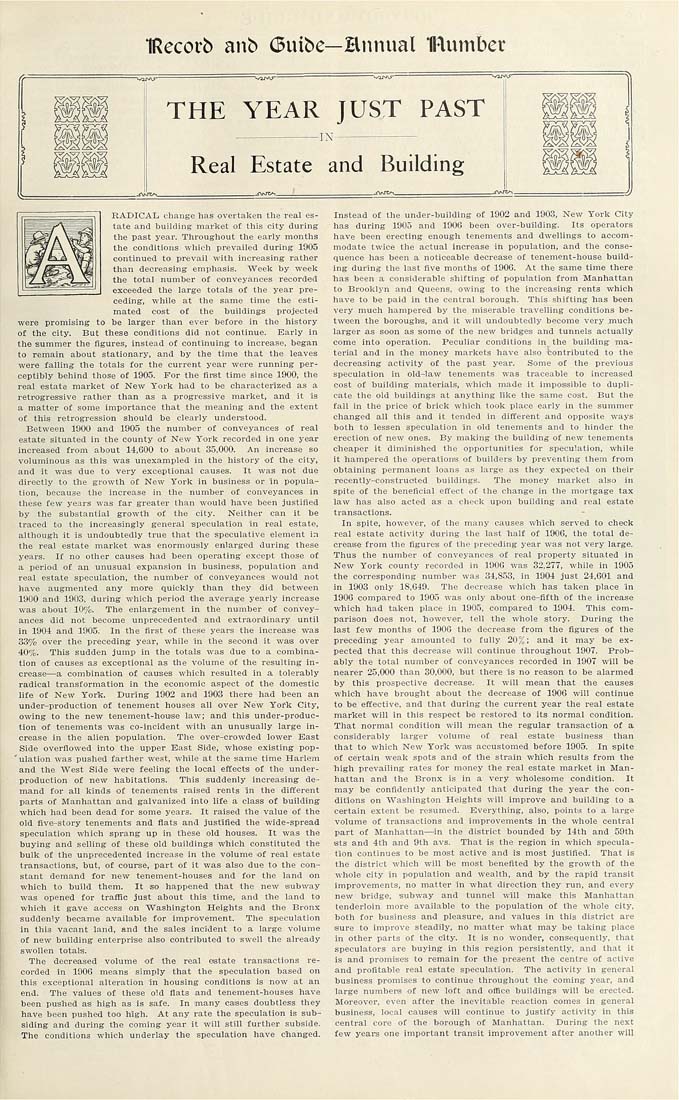Columbia University Libraries Digital Collections: The Real Estate Record
Use your browser's Print function to print these pages.
Real estate record and builders' guide: v. 79, no. 2028: January 26, 1907: Supplement

Text version:
Please note: this text may be incomplete. For more information about this OCR, view About OCR text.
IRecorb anb (Buibe—Hnnual flumbcv THE YEAR JUST PAST -IN- Real Estate and Building RADICAL change lias overtaken the real es¬ tate and building marivet of this city during tlie past year. Throughout the early months the conditions whicli prevailed during 1905 continued to prevail with increasing' rather than decreasing emphasis. "Week by week the total number of conveyances recorded exceeded the large totals of the year pre¬ ceding, while at the same time the esti¬ mated cost of the buildings projected were promising to he larger than ever before in tlie history oi the city. But these conditions did not continue. Early in the summer the figures, instead of continuing to increase, began to remain about stationary, and by the time that the leaves were falling the totals for the current year were running per¬ ceptibly behind those of 1905. For the fipst time since 1900, the real estate market of New York had to be characterized as a retrogressive rather than as a progressive market, and it is a matter of some importance that the meaning and the extent of this retrogression should be clearly undei-stood. Between 1000 and 1905 the number of conveyances of real estate situated in the county of New York recorded in one year increased from about 14,600 to about 35,000. An increase so voluminous as this was unexampled in the history of the city, and it was due to very exceptional causes. It was not due directly to the growth of New York in business or in popula¬ tion, because the increase in the number of conveyances in these few years was far greater than would have heen justified hy tlie substantial growth of the city. Neither can it be traced to the increasingly general speculation in real estate, although it is undoubtedly true that the speculative element in the real estate market was enormously enlarged during these years. If no other causes had been operating except those of a period of an unusual expansion in business, population and real estate speculation, the number of conveyances would not have augmented any more quickly than they did between 1900 and 1903, during which period the average yearly increase was about 10%. The enlargement in the number of convey¬ ances did not hecome unprecedented and extraordinary until in 1904 and 1905, In the first of these years the increase was 33% over the preceding year, while in the second it was over 40%. This sudden jump in the totals was due to a combina¬ tion of causes as exceptional as the volutne of the resulting in¬ crease—a combination of causes which resulted in a tolerably radical transformation in the economic aspect of the domestic life of New York. During 1902 and 1003 there had been an under-production of tenement houses all over New York City, owing to the new tenement-house law; and this under-produc¬ tion of tenements w^as co-incident with an unusually large in¬ crease in the alien population. The over-crowded lower East Side overdowed into the upper East Side, whose existing pop¬ ulation was pushed farther west, wliile at the same time Harlem and the West Side were feeling the local effects of the under¬ production of new habitations. This suddenly increasing de¬ mand for all kinds of tenements raised rents in the different parts of Manhattan and galvanized into life a class of building which had been dead for some years. It raised the value of the old five-story tenements and flats and justified the wide-spread speculation which sprang up in these old house's. It was the buying and selling of these old buildings which constituted the bulk of fhe unprecedented increase in the volume of reai estate transactions, but, of course, part of it was also due to the con¬ stant demand for new tenement-houses and for the land on which to build them. It so happened that the new eubway was opened for trafflc just about this time, and the land to which it gave access on Washington Heights and the Brons suddenly became available for improvement. The speculation in this vacant land, and the sales incident to a large volume of new building enterprise also contributed to swell the already swollen totals. The decreased volume of the real e